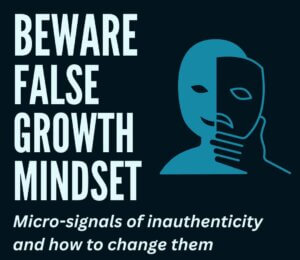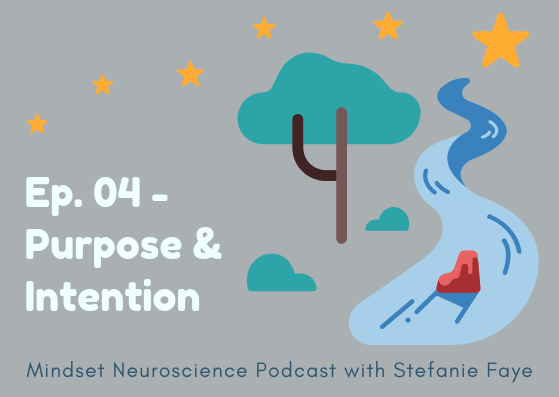You can't teach Growth Mindset only with words.
This is because growth mindset is a 'concept'. A concept is something abstract, like ‘passion' or 'perseverance’. Concepts are a way we try to use words to label experiences, behaviors and feelings. But they're a few layers out from the actual lived experience.
You can’t ‘teach passion’ as concept you've heard about secondhand, because a person has to experience it themselves to know it. It’s the same with ‘growth mindset’.
But there is something you can do with a ‘concept’ like passion, perseverance and ‘growth mindset’.
You can Live it. And then you can Embody and Model it.
That way, when you talk about it, you have personal anecdotes, examples, feelings you can share. You don't need secondhand phrases from other people (or if you do use them, they feel powerful and personal to you).
The problem is, it can be difficult to spark and cultivate a concept like growth mindset because it can often be overused and used by people who have not necessarily really understood and reflected on it as deeply as they could.

Research is also pointing to what Carol Dweck has called the false growth mindset.
Educators and leaders learn about growth mindset. They are using the terminology. They're doing all the things on the checklist about promoting a growth mindset (Dweck, 2016).
But when you observe their behavior in the classroom or workplace, it's clear that they have not really internalized it, and it's not really being reflected in their behavior. They're still writing people off. They're still stereotyping. They're labeling. They're not truly believing in many people’s ability to develop and change their brain and promote their own ability to develop their talents. In research on college students, this type of false growth mindset in the teacher leads students to adopt or continue with fixed mindset behavior (Buttrick, 2020).
People can tell the difference between someone who knows about something and someone who knows it, who lives it.
When we are truly authentic and aligned with what we are teaching and talking about, we ‘mean’ it... What does that mean? That whatever the concept is - in this case mindset - we feel clear about how it lives and feels inside our body, and how it plays out within our actual movements, thoughts, voice frequencies, words, actions and vibrations.
We are able to use real-life, often subtle examples of how we have shifted what we noticed, or how we've felt a process working through us.
We don't need catchphrases because the sensations, connecting-of-dots and thoughts that come to us about what we are learning are things we feel and embody. And those feelings and connections are what we can use to teach others about what we have lived and internalized for ourselves.
These things make up the ‘micro-signals of authenticity’
A 3 step process that I think is helpful to think about is what I call L.I.T. - Learn, Internalize, Teach. It’s great to learn new things, but it’s important to internalize them before - or at least in parallel - to teaching them.
Two examples of how we can Internalize growth mindset is to:
- remember times when we were first learning something,
- push ourselves to learn new things so that we can become more aware of what types of inspiration, words, teachings, help us persevere and not give up on ourselves when things get awkward, difficult and uncomfortable.
If we’re going to teach growth mindset to others, they need us to reflect on and internalize our own processes and how we navigate taking something on where we feel like we might fail or lose or be rejected - but we find a way to push through that.
Learning and change = new brain-body algorithms
Any time you are creating CHANGE... Any time you are learning something new or trying to do something that is not the way you have done it before, it means that you are trying to change the future, and not repeat the past. This requires new resources, algorithms, blood flow, and different kinds of electrochemical activity.
This process will always feel a bit uncomfortable and feel like effort. It is the opposite of ease.
And the brain-body system, which is wired for efficiency, tends to lead us to gravitate towards familiar patterns.
Changing our behaviors and patterns to align more with what feels healthy and LIFE-ENHANCING isn’t easy.
But with an internalized growth mindset, we understand that effort is part of the process, and that talents, responses to situations and relationship skills are dynamic and changeable. We also acknowledge that there's going to be some feelings of unfamiliarity and unease when we are trying to find new ways of experiencing life.
By embracing the discomforts and awkwardness that come with learning and change, we pave the way for the building of new neural pathways and behaviors that can improve our lives and help us tap into versions of ourselves we know we’re capable of.
You can also listen to more about the False Growth Mindset and Micro Signals of Authenticity in this mini podcast
References
Buttrick, Nick. (2020). False growth mindsets negatively impact student beliefs and performance. link to paper
Dweck, C. (2016, January 11). Recognizing and overcoming false growth mindset. Edutopia. Retrieved from https://www.edutopia.org/blog/recognizing-overcoming-false-growth-mindset-carol-dweck
Register for the FREE Neuroscience of Mindset workshop to learn more about how to truly embody growth mindset and how to see through the myths and often missed aspects of mindset that make it one of the most powerful leverage points for learning, growth and personal evolution.
"Your brain - every brain - is a work in progress. It is 'plastic.' From the day we're born to the day we die, it continuously revises and remodels, improving or slowly declining, as a function of how we use it."
― Michael Merzenich, Neuroscientist,
Author of Soft-Wired: How the New Science of Brain Plasticity Can Change your Life



